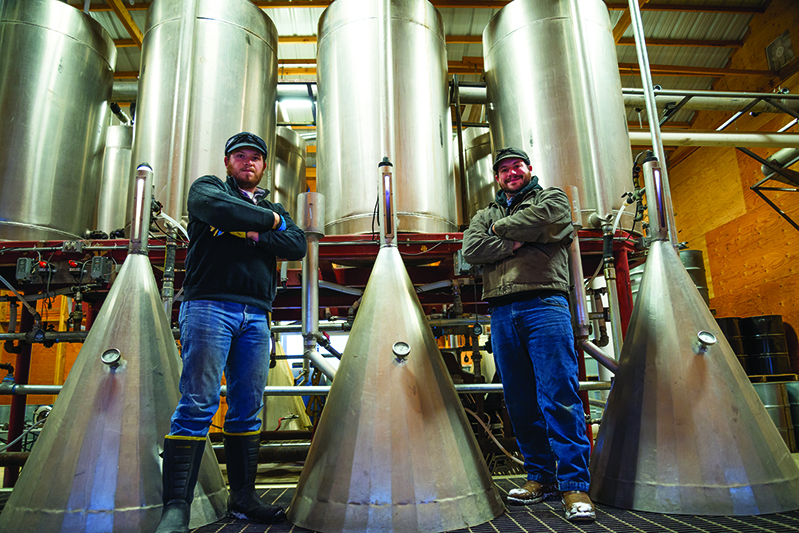The Younger Generation Breaks Into Farming
Written By Suzanne Waring • Photography by Daphne Wade
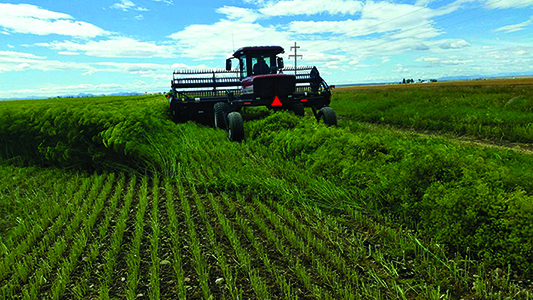
Harvesting begins with the dill being swathed into rows so it can be picked up, chopped, and blown into trailer-like tubs. Photo courtesy of Great Northern Farms.
Both young men are starting out with the willingness to work hard at what they have researched to be a very good idea. They hail from the Flathead area where the Brostens, a farming family, are keenly aware that there’s a good market for both mint and dill oil. Much of the soil where mint has been traditionally grown in parts of Washington and Oregon has contracted verticillium wilt fungus that will take years to eradicate. Planning to fill the gap in production, these young men sought irrigated acreage that was virgin to mint and located near the 48th parallel where these crops thrive in warm days and cool nights.
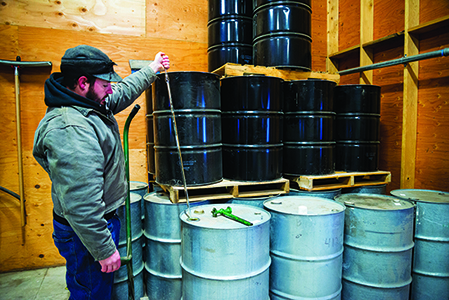
Larry Johnston checks the oil that is stored in 55-gallon barrels.
After purchasing the land in November 2015, the men designated two acres as their headquarters. Besides buying equipment—such as an unusual looking implement that drills mint roots during the planting process, Brosten and Johnston raised a 36’ x 96’ building where the still and boiler were installed. Presently eight distilling units fill the larger room, but the set-up has been created for four more. The boiler is in the second room. The men constructed the walls of the building on the ground next to the concrete pad. On a designated day, several area farmers arrived to help them raise the walls into place. “It felt like an old-fashioned barn raising,” said Johnston.
Brosten and Johnston purchased the distilling units from a California man who was ready to retire, but they had been built in the Kalispell area, so the Brostens were aware of them. “We finished putting everything together in the nick of time because the first crop of dill was ready to be harvested,” said Johnston. In the spring, they had planted 30 acres of mint and 340 acres of dill on leased land.
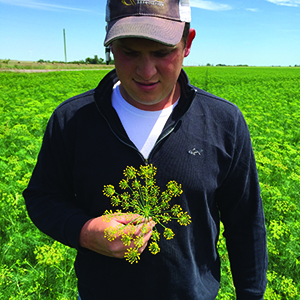
Zach Brosten inspects a dill cluster. A field of dill is behind him. Photo courtesy of Great Northern Farms.
Both mint and dill are harvested when they are at their prime by swathing, picking up the windrows, chopping, and blowing the foliage into a covered trailer—called a tub in this case. A tub usually fills within an acre to an acre and half. Unlike most farming operations where the job is finished after the crop has been harvested and taken to a distributor or storage, Johnston and Brosten go a step further with dill and mint. They process their crop into an oil. After the tubs are full, they are moved to the extraction building where they are sealed and attached to piping that injects steam produced by the boiler inside the building. The propane for the boiler comes from a 6000-gallon tank that has to be filled every other day and sometimes every day, during extraction processing.
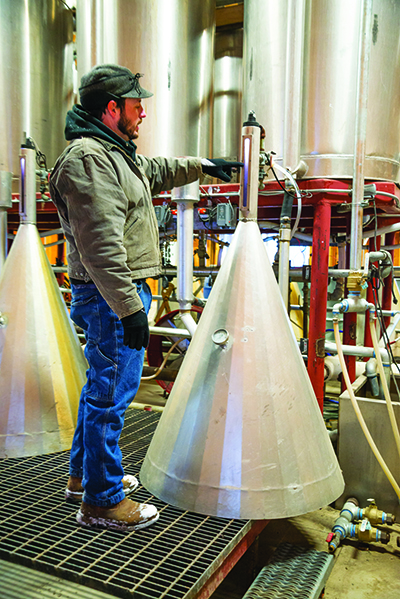
Larry Johnston checks the oil level on the water at one of the stills.
Both herbs can be distilled at the same time but on a different set of stills. A switch from one herb to the other in the same unit calls for a good cleaning. Because more dill was processed this last year, most of the time the extraction building has a dill odor to it, and frequent passers-by called it the “pickle barn.”
Dill is cut high on the plant to retrieve the head and not so much stem. Dill oil is used primarily to make dill pickles, but it has other uses. It is frequently added to baked goods, condiments, snacks, and meat products.
A field of mint can be harvested for its leaves yearly for approximately five years when it begins to lose its productive nature. Because of the reduced moisture in this part of the country, only one cutting is taken annually. Since the oil comes from its leaves, the plant is cut closer to the ground. Both spearmint and peppermint can be grown, but peppermint is preferred because its oil is stronger and less is added to get the right flavor. Peppermint also has the flavor that many Americans prefer. Mint oil is mainly used in the oral health industry, such as toothpaste and mouthwashes; over-the-counter, digestion-soothing products; teas; and food, especially candies.
Mint and dill are also grown in India and Canada, but the oil produced in the United States and Canada is preferred because the process of mechanically harvesting and immediately extracting the oil produces a better quality product. Johnston and Brosten sell the oil to a broker who markets it to food- and toiletry-production companies. The foliage byproduct is piled nearby to be scattered on the soil to decay, thus improving the loam of the soil. It is also used for cattle feed, mulch for gardens, and animal bedding. Brosten and Johnston find that there’s work to be done all year, so they are at the property daily.
Both men have purchased homes in the area. “We will be growing and extracting mint, dill, and possibly other herb oils for the long haul. We have been welcomed by those living nearby, and we look forward to taking part in community activities,” said Johnston.
